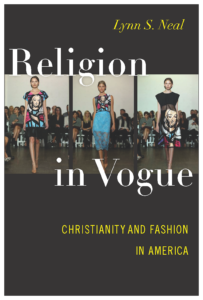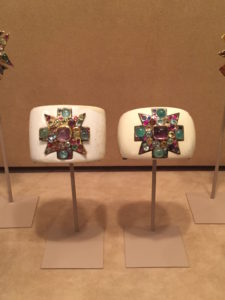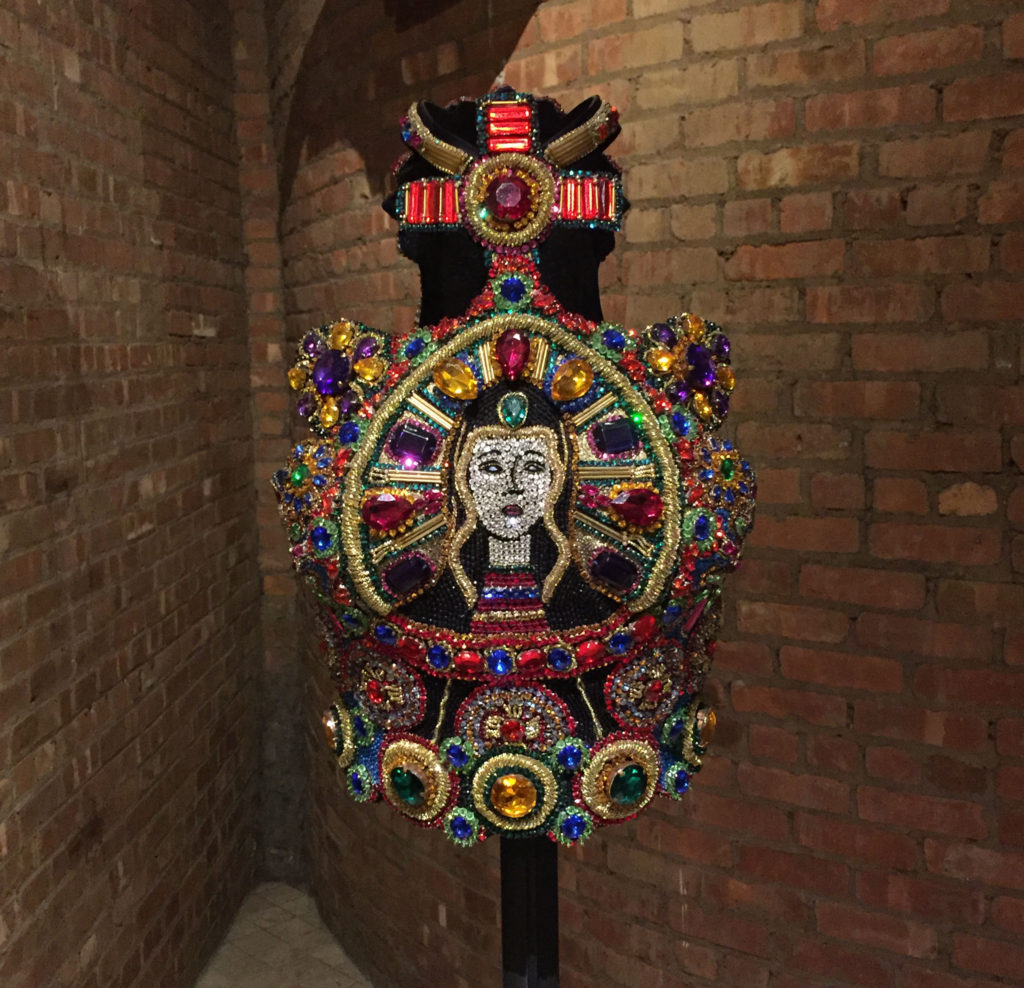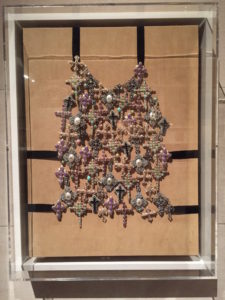Religion in Vogue: Christianity and Fashion in America
A book excerpt with an introduction by the author
 Headlines frequently proclaim the latest fashion furor and faux pas committed by designers and celebrities. In 2002, tabloids announced the Vatican’s furor over celebrities such as Jennifer Aniston, Naomi Campbell, and Catherine Zeta-Jones for wearing cross necklaces. In the 1980s it was Madonna who garnered the antipathy of the Christian Right with her cross jewelry, song lyrics, and music videos. Designer Lisa Burke had to apologize for and not produce her 2011 bathing suit featuring the Hindu goddess Lakshmi, while critics described Jean Paul Gaultier’s nun-inspired collection from the late 1980s as shocking and in bad taste. Controversy and antagonism often characterize the relationship between and coverage of religion and fashion. This framing, though, obscures the long, intertwined, and often complementary history between religion and fashion as seen in the designs of Gianni Versace, Dolce & Gabbana, and Alexander McQueen, who have been lauded for their religiously-inspired designs. Using a diverse range of fashion sources, including designs, jewelry, articles in fashion magazines, and advertisements, Religion in Vogue chronicles this complex intersection—the moments of conflict and contestation, as well as the instances of praise and popularity—as it traces how God got on a dress or, put another way, how Christian figures and symbols became a prominent part of the fashion industry. Doing so challenges us to consider how the fashion industry has shaped our current conceptualizations of American Christianity, religion, and spirituality.
Headlines frequently proclaim the latest fashion furor and faux pas committed by designers and celebrities. In 2002, tabloids announced the Vatican’s furor over celebrities such as Jennifer Aniston, Naomi Campbell, and Catherine Zeta-Jones for wearing cross necklaces. In the 1980s it was Madonna who garnered the antipathy of the Christian Right with her cross jewelry, song lyrics, and music videos. Designer Lisa Burke had to apologize for and not produce her 2011 bathing suit featuring the Hindu goddess Lakshmi, while critics described Jean Paul Gaultier’s nun-inspired collection from the late 1980s as shocking and in bad taste. Controversy and antagonism often characterize the relationship between and coverage of religion and fashion. This framing, though, obscures the long, intertwined, and often complementary history between religion and fashion as seen in the designs of Gianni Versace, Dolce & Gabbana, and Alexander McQueen, who have been lauded for their religiously-inspired designs. Using a diverse range of fashion sources, including designs, jewelry, articles in fashion magazines, and advertisements, Religion in Vogue chronicles this complex intersection—the moments of conflict and contestation, as well as the instances of praise and popularity—as it traces how God got on a dress or, put another way, how Christian figures and symbols became a prominent part of the fashion industry. Doing so challenges us to consider how the fashion industry has shaped our current conceptualizations of American Christianity, religion, and spirituality.
The excerpt below, from Chapter 3, “Accessorizing the Cross,” provides an overlooked perspective on the history of cross jewelry.
***
Chanel’s Catholic past, provocative persona, and designer status combined to make her cross jewelry simultaneously fashionable yet tasteful, traditional yet modern, respectful yet playful. This can be seen in one of the most famous Chanel jewelry design motifs. In the 1930s, she hired Fulco Santo Stefano della Cerda, Duke of Verdura, a Sicilian aristocrat, to design with and for her. This collaboration produced one of the most iconic pieces of Chanel jewelry: enameled cuffs featuring Maltese crosses adorned with colorful gems. This cross became one of the hallmarks of Chanel’s jewelry designs and numerous photographs show Chanel wearing the iconic cuffs.

Maltese cross (Photo: Lynn S. Neal)
A distinct variation on the cross shape and symbol, the Maltese iteration nevertheless drew upon the Christian past. In 1126 the Knights Hospitallers of Saint John adopted the Maltese cross as their symbol, identified by its eight points. Some accounts suggest that a tunic bearing the symbol protected the Knights from their enemy’s weapons, while others emphasize that the eight points of the Maltese cross represent the Knight’s eight obligations: “to live in truth, have faith, repent one’s sins, give proof of humility, love justice, be merciful, be sincere and whole-hearted, and to endure persecution.” The Maltese cross shape invoked ideas about Christian virtue and divine protection. The selection of this shape and its spiritual connotations aligned with the ways fashion magazine articles and advertisements emphasized the visual and the symbolic in Christianity, as well as the supernatural powers attributed to sacred objects and fashion products.
In addition, the Chanel-Verdura cuffs provided a fashionable and playful take on this traditional symbol that offered interpretive possibilities. Rather than Knights wearing starkly drawn crosses on their robes or shields, the cuffs sported a decontextualized Maltese cross adorned with numerous precious gems, connoting luxury and sophistication. These characteristics also identified it as a fashion item, rather than a devotional aid. At the same time, though, by preserving the basic outline of the Maltese cross and evoking the shape’s exotic Maltese and Christian history, the cuffs connoted ideas about the object’s potential spiritual power. As a result, the Chanel-Verdura cuffs provided consumers with a sophisticated way to simultaneously exhibit fashion and religion.

Another example of Christian-inspired fashion from Versace with a jeweled image of Mary (Photo: Lynn S. Neal)
In his classic essay “The Work of Art in the Age of Mechanical Reproduction,” Walter Benjamin laments arts’ loss of “aura” through its replication, but he also highlights how the reproduction of an art object detaches it from tradition and “meet[s] the beholder . . . in his own particular situation.” In a similar way, the Chanel-Verdura cuff offered potential consumers proximity to and personalization of the meanings (spiritual and cosmopolitan) ascribed to the source—Malta and the Maltese cross. Consumers did not need to be spiritual pilgrims who visited Malta; rather, they could invoke Malta and any potential supernatural powers associated with its cross through purchasing a reproduction and wearing it. As discussed in chapter 2, the pleasure and possibility of such objects resided not in a zero-sum game based on Chanel’s sincerity or the object’s authenticity, but rather in a back-and-forth movement between “illusionism and realism.” Birgit Meyer explains, “As belief becomes thus vested in the image, it becomes hard to distinguish between belief and make-believe, miracles and special effects, or truth and illusion.” The Chanel-Verdura cuffs offered consumers this possibility—an object that could transform their sartorial and spiritual lives.
Fashion columns in the 1930s commented on Chanel’s jewelry designs but said little about the inclusion of this religious symbol. Yet, the cross remained a vital part of her design aesthetic, and Verdura designed numerous variations of the Maltese cuff. Many of these pieces were reproduced in the 1950s, when the House of Chanel reopened after the war. So renowned are these cuffs, that in 1987, when Diana Vreeland, former fashion editor of Harper’s Bazaar and former editor-in-chief of Vogue, auctioned off her jewelry at Sotheby’s, including four of Chanel’s cuffs, it made the New York Times.
Chanel’s jewelry designs also included styles of crosses that modernized another historic, “traditional,” and “authentic” source. Chanel was inspired by the Byzantine period in Christian history, renowned in fashion for its rich artistic repository. “From the point of view of jewelry, no empire was ever richer in traditions than that of the Byzantines.” One historian notes, “The symbolism of Christianity pervades much Byzantine jewelry, and pendant crosses (some of which also served as reliquaries) were among the earliest and most popular pieces.” Chanel experienced this rich tradition of jewelry and religion on a visit to the Tomb of Galla Placidia in Ravenna, Italy. The site, which dates to the fifth century CE, features numerous mosaics of biblical figures, saints, and Christ the Good Shepherd. It inspired Chanel. According to Patrick Mauriés, in Jewelry by Chanel, the impact of this visit “can be seen especially clearly in the great number of crosses . . . which she designed using combinations of pearls and precious stones.”

Cross jewelry (Photo: Lynn S. Neal)
In the 1950s, Chanel hired French jeweler Robert Goossens to work on Byzantine-inspired designs, which meant the use of gold, colored gemstones, and Christian symbols. Given this inspiration, Goossens and Chanel designed numerous cross pendants and brooches, many of which were produced in 1954, when the House reopened. In comparison with the bright and shiny character of the Chanel-Verdura Maltese cross cuff, the Byzantine cross pendants and brooches evince a simpler aesthetic. They use gold and precious gems, but the settings and style reflect their Byzantine inspiration. In one design, from the 1960s, gold, pearl, turquoise, and tourmaline adorn the face of the cross, while a saint is engraved on the reverse. The turquoise stones are rough and uneven, and the gold has a similar, almost primitive, appearance, and the saint on the back adds another layer of simplicity and austerity to this grand piece. Here, again, we see Chanel’s jewelry offer a modern and sophisticated interpretation of a historic and traditional form. Her use of precious gems echoes the grandeur of the Byzantine style and highlights the wealth of the era and the consumer. At the same time, the simplicity of the settings and the inclusion of the saint recall ideas about devotion to and the protection of the divine.
Despite Chanel’s evolving aesthetic, the cross remained a recognizable element of her jewelry designs that fashion journalists highlighted in the 1950s. For example, in a 1957 New York Times article, Phyllis Lee Levin described the latest fashion trend in “Spring Clothes Deserve Medals.” She notes “that the spring suit lapel without a bold jewel will look forlorn.” Levin attributes this trend to the work of Coco Chanel, “a kind of Queen Mother of costume jewelry.” She explains, “In many cases, the outlines of her wonderful tangles of sapphires and emeralds followed the classic Maltese cross, star and medallion shapes.” More than twenty years later, fashion reporters continued to mention Chanel’s influence in the realm of jewelry, especially her use of the Maltese cross. For example, in 1988 fashion journalist Bernadine Morris characterized the details of designer Yves Saint Laurent’s collection as “an unmistakable homage to Chanel,” as the jewelry adorning his models included Maltese crosses.
Lynn S. Neal is Professor and Chair of Religious Studies at Wake Forest University. An award-winning teacher of Religious Studies, Neal regularly teaches courses on religion and popular culture, new religious movements, and religion in America. She is the author of Religion in Vogue: Christianity and Fashion in America and Romancing God: Evangelical Women and Inspirational Fiction, and the co-editor of Religious Intolerance in America: A Documentary History, Second Edition.